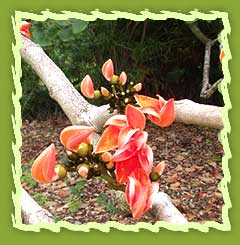
Butea Superba, Bastard Tea, Flame of Forest
(Butea Monosperma)
Description
A medium sized deciduous tree, very conspicuous when in flower, 12-15m in height with gum-containing grey bark exfloiating in irregular pieces, and somewhat crooked trunk, leaves 3-foliate, leaflets coraceous, obtuse, glabrous above when old, finely silky and conspicuously reticulately veined beneath; flowers bright orange red, large, in rigid racemes; fruits podsm thickened at the sutures.
Chemical Constituents
The composition of the leaves varies with the place of origin. Analysis of the leaves from jammu; crude protein crude fibre, ether extr, N-free extra, minerals, calcium, and phosphorus.
Cosmetic Uses
Purifying, draining, astringent, cooling, anti-inflammatory. Butea Superba has proven for me to be a safe, side effect free way of raising low testoterone levels. It has helped restore for me lost physical strength and stamina.
Medicinal Uses
The leaves are astringent, anti-inflammator, anodyne and aphrodisiac, and are useful in pimples, boils, flatulence, colic, worm infestation, inflammations, arthralgia and haemorrhoids. The flowers are astringent, sweet, cooling constipating, aphrodisiac, haemostatic,diuretic, febrifuge, depurative and tonic. They are useful in vitiated conditions of pitta and kapha, diarrhoea, haemorrhoids, menorrhagia, strangury, fever, leprosy , skin diseases, swellings, hyperdispsia, haemoptysis, arthritis, burning sensation, bone fractures, and are very efficacious in birth control. The seeds are purgative, ophthalmic, anthelmintic, rubefacient, depurative and tonic. They are useful in herpes, skin diseases, ringworm, ophtlamopathy, epilepsy, round worm, arthritis, flatulence, constipation and diabeters. The gum known as Bengalkino or Buteakino is astringent, constipating, haemostatic, aphrodisiac, depurative and tonic, and is useful in diarrohoes, haemorrhoids, haemoptysis, haematemesis, diabetes, leprosy, skin diseases, ulcer, pharyngodynia, general debility, hyperacidity, dyspepsia and fever. The ash of the tender branches is useful in abdominal disorders such as flatulence, colic etc.
A medium sized deciduous tree, very conspicuous when in flower, 12-15m in height with gum-containing grey bark exfloiating in irregular pieces, and somewhat crooked trunk, leaves 3-foliate, leaflets coraceous, obtuse, glabrous above when old, finely silky and conspicuously reticulately veined beneath; flowers bright orange red, large, in rigid racemes; fruits podsm thickened at the sutures.
Chemical Constituents
The composition of the leaves varies with the place of origin. Analysis of the leaves from jammu; crude protein crude fibre, ether extr, N-free extra, minerals, calcium, and phosphorus.
Cosmetic Uses
Purifying, draining, astringent, cooling, anti-inflammatory. Butea Superba has proven for me to be a safe, side effect free way of raising low testoterone levels. It has helped restore for me lost physical strength and stamina.
Medicinal Uses
The leaves are astringent, anti-inflammator, anodyne and aphrodisiac, and are useful in pimples, boils, flatulence, colic, worm infestation, inflammations, arthralgia and haemorrhoids. The flowers are astringent, sweet, cooling constipating, aphrodisiac, haemostatic,diuretic, febrifuge, depurative and tonic. They are useful in vitiated conditions of pitta and kapha, diarrhoea, haemorrhoids, menorrhagia, strangury, fever, leprosy , skin diseases, swellings, hyperdispsia, haemoptysis, arthritis, burning sensation, bone fractures, and are very efficacious in birth control. The seeds are purgative, ophthalmic, anthelmintic, rubefacient, depurative and tonic. They are useful in herpes, skin diseases, ringworm, ophtlamopathy, epilepsy, round worm, arthritis, flatulence, constipation and diabeters. The gum known as Bengalkino or Buteakino is astringent, constipating, haemostatic, aphrodisiac, depurative and tonic, and is useful in diarrohoes, haemorrhoids, haemoptysis, haematemesis, diabetes, leprosy, skin diseases, ulcer, pharyngodynia, general debility, hyperacidity, dyspepsia and fever. The ash of the tender branches is useful in abdominal disorders such as flatulence, colic etc.
No comments:
Post a Comment